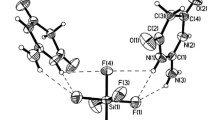Abstract
Gem diphosphonates, vicinal polyphosphonates and polyphosphates were found to be effective inhibitors of calculus formation in rats. Sodium citrate and trisodium phosphate were found ineffective. Accumulation of calculus was inhibited by inclusion of the phosphonates in the calculus diet or by topical application of aqueous solutions. The anti-calculus effect of phosphonates was topical rather than systemic and was related to the relative effectiveness of these compounds to inhibit crystal growth of hydroxyapatite. A calculus grading method was used and was reproducible among several graders in assessing calculus production and inhibition. Calculus production in weanling animals fed the control diet occurred at a rapid rate under the conditions described, with maximum scores being reached after about 18 days.
Résumé
Des diphosphonates de gemme, des polyphosphonates voisins, et des polyphosphates semblent constituer des inhibiteurs actifs de la formation du tartre des rats. Le citrate de sodium et le phosphate trisodique sont inactifs. Les dépôts tartriques sont inhibéspar adjonction des phosphonates à l’alimentation ou par application locale de solutions aqueuses. L’effet antitartre des phosphonates est local plutôt que général et semble lié à l’efficacité relative de ces composés vis à vis de l’inhibition de la croissance cristalline de l’hydroxyleapatite. Un indice de tartre est utilisé et s’avère reproductible pour divers examinateurs pour estimer le dépôt et l’inhibition du tartre. La formation de ce dernier chez des animaux sevrés, soumis à une alimentation témoin, est rapide dans les conditions décrites avec des valeurs maximales atteintes au bout de 18 jours.
Zusammenfassung
Geminale Diphosphonate, vicinale Polyphosphanate und Polyphosphate erwiesen sich als wirksame Hemmer der Zahnsteinbilding in Ratten. Natriumcitrat und Trinatriumphosphat waren unwirksam. Eine Anhäufung von Zahnstein wurden durch Beigabe der Phosphonate in der Diät oder durch lokale Anwendung von wäßrigen Lösungen verhindert. Die steinhemmende Wirkung von Phosphonaten war eher lokal als systemisch und hing zusammen mit der relativen Wirksamkeit dieser Substanzen bei der Hemmung des Kristallwachstums von Hydroxyapatit. Die Steinmeßmethode wurde verwendent und war bei der Festlegung von Steinproduktion und-hemmung mit mehreren anderen Methoden reproduzierbar. Die Steinbildung bei entwöhnten Tieren, welche die Kontrollnahrung erhielten, erfolgte bei den beschriebenen Bedingungen rasch, wobei die maximalen Werte etwa nach 18 Tagen erreicht wurden.
Similar content being viewed by others
References
Baer, P. N., Beyes, P. H., White, C. L.: Studies on experimental calculus formation in the Rat. XII. On the transmissibility of factors affecting dental calculus. J. Periodont.39, 86–88 (1968).
Conroy, C. W., Sturzenberger, O. P., Ballmer, B. W., Swancar, J. R., Zimmerman, E. R.: The effect of a sodium etidronate dentifrice on calculus and gingivitis in adults. J. dent. Res., Suppl., Abstract #208, 100 (1972).
Draus, F. J., Lesniewski, M., Miklos, F. L.: Pyrophosphate and hexametaphosphate effects inin vitro calculus formation. Arch. oral Biol.15, 893–896 (1970).
Fleisch, H., Russell, R. G. G., Bisaz, S., Termine, J. D., Posner, D. S.: Influence of pyrophosphate on the transformation of amorphous to crystalline calcium phosphate. Calc. Tiss. Res.2, 49–59 (1968).
Francis, M.D.: The effectiveness of anticaries agents in rats using an incipient carious lesion method. Arch. oral Biol.11, 141–148 (1966).
Francis, M. D.: The inhibition of calcium hydroxyapatite crystal growth by polyphosphonates and polyphosphates. Calc. Tiss. Res.3, 151–162 (1969).
Francis, M. D., Briner, W. W.: Animal calculus: methods of evaluation and of dietary control. J. dent. Res.48, 1185–1195 (1969).
Francis, M. D., Briner, W. W.: The effect of phosphonates on dental enamelin vitro and calculus formationin vivo. Calc. Tiss. Res.,11, 1–9 (1973).
Francis, M. D., Russell, R. G. G., Fleisch, H.: Diphosphonates inhibit formation of calcium phosphate crystalsin vitro and pathological calcificationin vivo. Science165, 1264–1266 (1969).
Francis, M. D., Webb, N. C.: Hydroxyapatite formation from a hydrated calcium monohydrogen phosphate precursor. Calc. Tiss. Res.6, 335–342 (1971).
Johansen, E.: A new technique for oral examination of rodents. J. dent. Res.31, 361–365 (1952).
McCune, H. W.: Oral care products to Procter & Gamble Company, Derwent Netherlands Patents Report4, Sec. 5, 2 (1967).
McCune, H. W.: Oral care products, Great Britain 1, 110, 987, August 21, 1968.
Mühlemann, H. R., Bowles, D., Schait, A., Bernimoulin, J. P.: Effect of diphosphonate on human supragingival calculus. Helv. odont. Acta14: 31–33 (1970).
Shannon, I. L., Carroll, E. C., Madsen, K. O.: Dietary influence on the formation of dental calculus in rats. J. periodont. Res5, 191–195 (1970).
Snedecor, G. W., Cochran, W. G.: Statistical methods, p. 273–275, 6th ed. Ames, Iowa: Iowa State College Press 1967.
Sturzenberger, O. P., Swancar, J. R., Reiter, G.: Reduction of dental calculus in humans through the use of a dentifrice containing a crystal-growth inhibitor. J. Periodont.42, 416–419 (1971).
Vogel, J. J., Amdur, B. H. Inorganic pyrophosphate in parotid saliva and its relation to calculus formation. Arch. oral Biol.12, 159–163 (1967).
Author information
Authors and Affiliations
Rights and permissions
About this article
Cite this article
Briner, W.W., Francis, M.D. In vitro andin vivo evaluation of anti-calculus agents. Calc. Tis Res. 11, 10–22 (1973). https://doi.org/10.1007/BF02546592
Received:
Accepted:
Issue Date:
DOI: https://doi.org/10.1007/BF02546592




